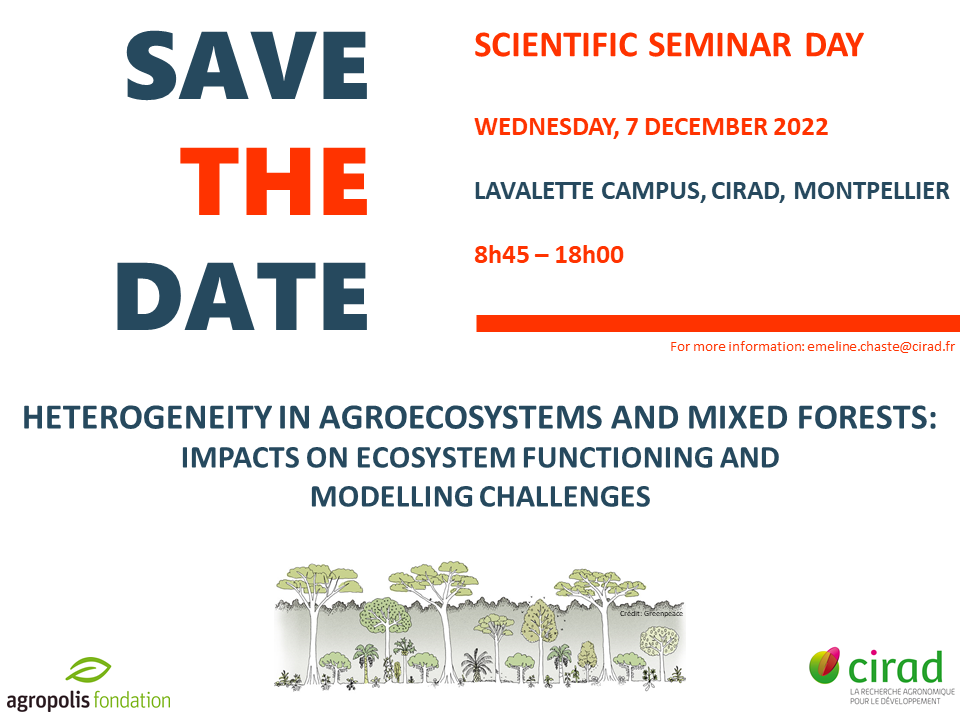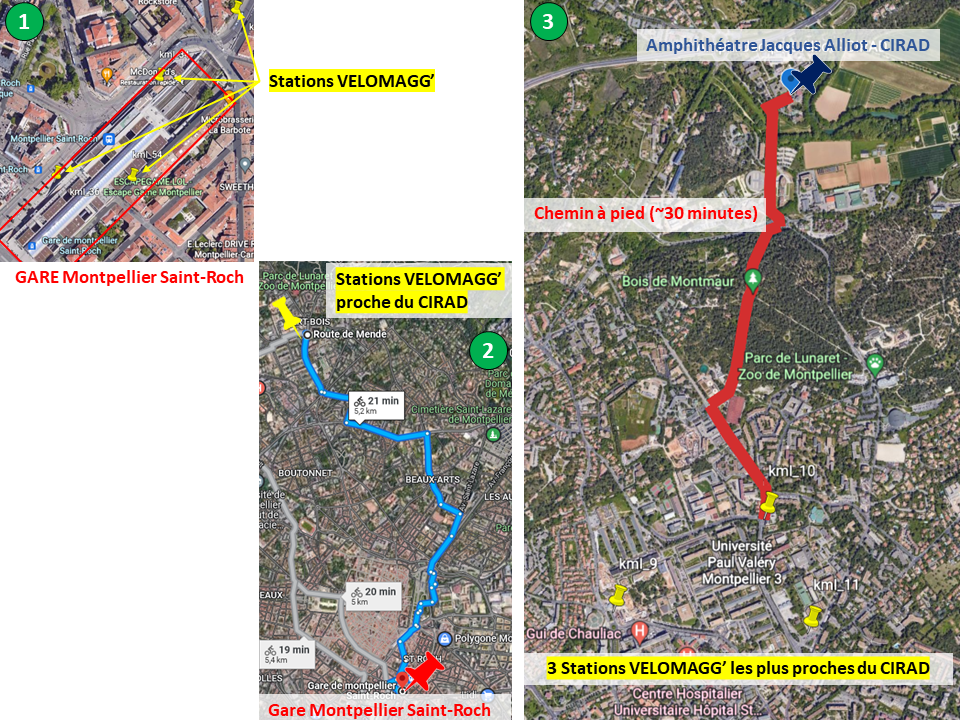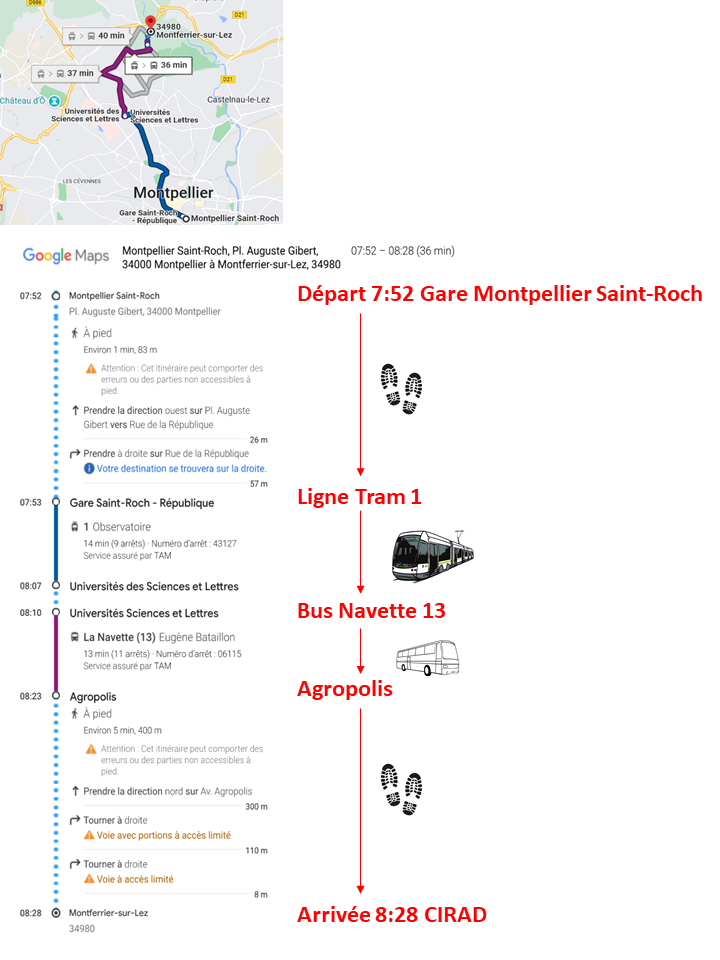 Journée séminaire scientifique :
Journée séminaire scientifique :
L'hétérogénéité dans les agroécosystèmes et les forêts mixtes:
impacts sur le fonctionnement de l'écosystème et défis en modélisation
Résumé
Quel est l'impact des interactions multi-espèces sur le fonctionnement des écosystèmes et comment modéliser les systèmes de végétation multi-couches?
Les systèmes à coexistence multi-espèces intégrant des arbres de différentes espèces (i.e. forêts mixtes) ou des arbres et des cultures (i.e. agroforesterie) incluent des espèces annuelles et pérennes sur un gradient de diversité allant de 2 à n espèces. Les agro-forêts et forêts mixtes, qui sont identifiées comme des solutions fondées sur la nature pour lutter contre les changements climatiques et la crise de la biodiversité, sont des systèmes complexes de végétation à plusieurs couches. Les flux et les conditions microclimatiques de ces systèmes sont affectés à de multiples échelles par la structure tridimensionnelle complexe et la variabilité de la phénologie. Leurs structures à une ou plusieurs strates se traduisent par des arrangements horizontaux et verticaux au-dessus et au-dessous du sol qui peuvent maximiser l’utilisation de la lumière, de l'eau et des nutriments, modifier l'évapotranspiration, déplacer l'équilibre énergétique des flux de chaleur sensible aux flux de chaleur latents. De telles altérations des conditions de croissance peuvent affecter la productivité des peuplements et la séquestration du carbone dans le sol ou la biomasse des arbres, la biodiversité globale et la fertilité des sols, la qualité de l'eau et de l'air, suscitant l'intérêt pour les systèmes de végétation multicouches.
La plupart des expérimentations de terrain étudiant les agro-écosystèmes et forêts mixtes se concentrent sur la production en analysant l'augmentation du stockage de carbone dans le sol et la biomasse résultant du mélange d'espèces. Plus récemment, des études ont exploré l'impact de l'hétérogénéité de ces systèmes sur les échanges d'eau, d'énergie et de carbone entre la végétation et l'atmosphère. Le nombre d'expériences augmente mais la grande diversité de ces systèmes hétérogènes et la lente maturation des arbres rendent difficile la compréhension de l'ensemble des réponses du systèmes à l'hétérogénéité et de leurs effets à long terme. En complement des données d’expérimentation, des modèles de simulation peuvent être utilisés pour prédire la croissance et les flux dans ces systèmes hétérogènes à l'échelle régionale ou continentale et ainsi vérifier si de tels systèmes pourraient contribuer à l'adaptation et à l'atténuation du changement climatique. Plusieurs modèles intégrant l'hétérogénéité structurelle et son impact sur l'interception des rayonnements, les flux d'eau et de nutriments ont déjà été développés et devraient être pris en compte dans tout nouvel effort pour estimer le potentiel climatique des agro-forêts et des forêts mixtes.
Cette conférence vise à fournir des informations sur (1) l'évaluation des impacts des systèmes de végétation multicouches sur le fonctionnement de l'écosystème, (2) les méthodes de mise à l'échelle de ces impacts et (3) le niveau actuel d’implémentation de l’hétérogénéité de ces systèmes dans les modèles. Il est crucial que les chercheurs qui étudient les systèmes de végétation multicouches s'intègrent dans un réseau interdisciplinaire transnational afin de promouvoir la coopération scientifique et technique pour identifier les prochains grands défis et les orientations futures de la modélisation et de l'analyse des données des systèmes de végétation hétérogènes.
Inscription
POUR S'INSCRIRE en présentiel ou en visio: Cliquez Ici (Gratuit mais obligatoire)
Localisation
Amphithéatre Jacques Alliot au CIRAD Montpellier
Campus de Lavalette - Bâtiment 4 - Avenue Agropolis - 34398 Montpellier Cedex 5
Connexion à distance à la conférence
Si vous êtes dans l'impossibilité de vous déplacer pour assister sur place, les conférences seront diffusées via la plateforme Microsoft Teams:
Cliquez ici pour suivre la conférence
Les informations de connexion pour le public extérieur au CIRAD:
Pour vous connecter en streaming à la conférence:
- Cliquer sur le lien ci-dessus
- Vous arrivez sur l’écran de connexion, sur le popup ouvrir Microsoft Teams cliquer sur le bouton Annuler
- Cliquer ensuite sur le bouton Regarder sur le web a la place
- Vous arrivez sur l’écran de bienvenue de l’évènement cliquer sur Participer de manière anonyme (et non sur Connexion)

Programme
| Time | Speaker | Talk |
|---|---|---|
| 8:45-9:00 |
Opening Seminar |
|
| 9:00-9:45 | Louise Leroux | How multifunctionnal are F.albida parklands in Senegal? A landscape scale assessment of multiple ecosystem services and its impact of food security |
| UPR AIDA, Univ Montpellier, CIRAD, Montpellier, France. Email: |
||
|
Faidherbia albida agroforestry parklands are widespread in Sub-Saharan Africa under 250-600 mm of annual rainfall. Given its potential to provide a large spectrum of ecosystem services (ES) largely displayed in the literature, F.albida parklands are now widely recognised as a promising option to meet the 2030 UN SDGs. However most evaluations were carried out at the tree scale and a landscape scale assessment of the multiple ES they provide, their interactions and their impact on food security, is still lacking. In this study we benefits from the recent advances in terms of Earth Observation (EO) combined with agricultural field monitoring and households surveys at landscape scale to (1) analyze the multiple ESs supplied by a Sahelian F.albida agroforestry parkland and their relationships and (2) to scrutinize the direct and indirect contributions of the F.albida parkland diversity to food availability and food access. |
||
| 9:45-10:30 | Damien Beillouin | State of the art of meta-analysis results focusing on the effect of agroforestry on ecosystem services |
| UR Hortsys, CIRAD/CAEC, Le Lamentin, Martinique. Email: |
||
|
Increasing the diversity of species in agricultural systems is expected to benefit biodiversity and enhance ecosystem services. A fast-growing literature on this subject has produced numerous qualitative and quantitative syntheses largely varying in their scope, quality, type of crop diversification considered, and indicators of ecosystem services investigated. It resulted in a fragmented evidence difficult to synthetize and analyze for most decision makers. Here, we quantified simultaneously the biodiversity, supporting, regulating and provisioning ecosystem services of agroforestry, and compared the results to other type of crop diversification: associated plants, intercropping, crop rotation and cultivar mixture. In this aim, we collected and integrated the results of 5156 experiments from 95 meta-analyses, covering more than 120 crops and 85 countries. Our results show that, all crop diversification strategies considered together, significant improvement of crop yields, associated biodiversity, and several ecosystem services including water quality, pest and disease control, and soil quality are obtained compare to less diversified systems. Yet, there was substantial variability in the results for each individual ecosystem service between the different diversification strategies. Agroforestry strikes out as a particularly promising strategy compared to the 4 others; that is able to substantially increase all the ecosystem services considered in our analysis, that is, associated biodiversity (+61%, [26%, 105%]), production (+35%, [12%, 62%]), water regulation (+45%, [13%, 87%]), water quality, pest and diseases control (+59%, [38%, 82%]), and soil quality (+19%, [16%, 23%]). We detailed these performances according to the type of agroforestry systems (e.g. parkland, alley cropping, hedgerows); and identified knowledges gaps. Further investigation is of interest to study the performance of systems where several diversification strategies are combined, and the economic performance of these systems, which have so far been poorly documented in the papers identified. |
||
| 10:30-11:00 | Coffee break |
|
| 11:00-11:45 | David Forrester | Modelling mixtures and uneven-aged forests: From pattern to process to application |
| CSIRO, Canberra, Australia. Email: |
||
|
Mixed-species forests are often proposed as a way to increase the level of various ecosystem services, including productivity, compared with monocultures. However, while mixtures may often be superior to monocultures, there are also many examples where they are not, so there needs to be a way to determine when and where mixtures are likely to be better or worse than monocultures at providing any given ecosystem service. Similarly, tree size inequality has been promoted for improving productivity, despite many examples of lower productivity with higher size inequality. Despite the many studies that have been published about mixtures or size inequality it can be very difficult to know how those results can be transferred from the journal articles to a specific forest with its unique set of silvicultural objectives, climatic and edaphic conditions. It is perhaps not surprising that the vast majority of the world’s plantations are even-aged and monospecific. The aim this project was to find an approach that could be developed and used to determine species combinations and silvicultural treatments for specific sites and species. Firstly, a framework was developed to explain the spatial and temporal changes in mixing effects that have been reported in the literature; complementarity increases as the availability of resource “X” declines (or climatic condition “X” becomes harsher) if the species interactions improve the availability, uptake or use efficiency of resource “X” (or interactions improve climatic condition “X”). This framework is based around the production ecology equation, which is useful when determining which processes and interactions are occurring in a mixture, how resources are partitioned between species and how strongly the interactions influence productivity. A second framework was used to explain why size inequality is sometimes positively correlated with stand growth, but negatively correlated elsewhere. This analysis indicated that size inequality is a side effect of changes in size-growth relationships and size distributions, which have a much more direct influence on stand growth. While these frameworks are useful for designing experiments and interpreting their results, they are considerable simplifications of reality and cannot easily be applied by foresters to a specific site and species composition. This is because multiple types of inter- and intra-specific interactions usually occur simultaneously (e.g. nitrogen fixation, increased light absorption, increased water-use efficiency …) and so different resource availability-complementarity patterns can occur for a given pair of species, depending on the prevailing climatic and edaphic conditions as well as the developmental stage, stand density, etc. This complexity cannot be depicted using the simple framework described above. In contrast, this complexity can be summarized using forest growth models. While many forest growth models have been developed, and some have even been applied to mixtures, it is very rare that the predicted mixing effects are compared with actual measurements of the mixing effects. In this study, the stand-level forest growth model 3-PG was modified of so that it could be applied to mixed-species forests and uneven-aged forests. Tree level models appeared not to be any more accurate (and often less accurate) than 3-PG, despite their greater complexity. There are several possible reasons. Two of these are that stand-level models summarise many processes that are linear at the stand level but non-linear at the tree level, and tree-level models often use stand level inputs for major resources (e.g. soil water and nutrients). Simple stand level process-based models like 3-PG appear to be useful tools when managing and designing mixed-species stands. |
||
| 11:45-12:30 |
Rémi Vézy (ANNULE) |
Why agroforestry systems are so difficult to model? A perspective on the algorithmic level of abstraction |
| UMR AMAP, CIRAD, Montpellier, France. Email: |
||
|
Agroforestry systems are notoriously difficult to model. First, because they require knowledge about at least two species instead of one in sole crop systems. Second, because at least one of the species is a perennial plant, which are more difficult to simulate than annual plants because the simulation’s error is cumulated throughout longer periods of time. Third, because mixing species implies more complex relationships between plants of different species ranging from facilitation to competition for resources, i.e. light, water and nutrients. And fourth, because the system is spatially heterogeneous for the above and below-ground components, which once more, complexify the system with heterogeneous microclimatic (e.g. radiation, temperature, humidity, wind…) and edaphic conditions (e.g. soil water content, evaporation, temperature…). In this talk I will present different projects I am working on, taking different paths towards a better integration of such effects in our modelling approach. I will talk about 3D reconstruction, Sahelian agro-silvopastoral ecosystems, intercropping systems, algorithm simplification, model coupling, and the need for high performance algorithms and programming languages that harness the full power of our computers and clusters in the search for scaling up highly non-linear processes. |
||
| 12:30-14:00 | Lunch time | |
| 14:00-14:45 |
Xavier Morin1 and Nicolas Martin-StPaul2 |
A new coupled model to test the effect of management and climate change scenarios on forest contributions to people |
|
1CEFE, Montpellier, France. Email: 2URFM, INRAE, Avignon, France. Email: |
||
|
Forests are complex socio-ecosystems now facing a key challenge: how promoting their ability of carbon sequestration without impacting the other contributions to people, while taking into account their vulnerability to climate change? To answer this question, we aim at testing the effect of different forest management scenarios on the forests contributions according to several climate scenarios, to analyze trade-offs and synergies between simulated contributions. To do so, we propose to develop a new coupled-model embedding several complementary forest models. Former attempts to forecast future forest contributions to people have mostly relied on correlative modelling frameworks and focused on carbon sequestration and wood products, neglecting the other contributions. Here we develop on an original modelling approach combining cutting-edge models, including the key relevant processes for our objectives: the species distributin model PHENOFIT allowing to simulate phenology and the likelihood of recruitment; the forest dynamics model ForCEEPS allowing to simulate growth, composition structure of forest stands, carbon sequestration and management actions; and the plant hydraulic model SurEAU allowing to account for microclimate and drought and heat stresses induced by climate change. In a long term perspective, we plan to also incorporate the soil dynamics model Yasso07. Each model has been chosen for its balance between realism (i.e. avoiding correlative tools) and feasibility (i.e. manageable models, parameters available for a large range of European species). Forest contributions will be directly derived from the model outputs (growth composition, carbon sequestration) or indirectly using empirical response functions (e.g. biodiversity vs structure, wildfire risk vs fuel and drought). This new model is developed on the platform Capsis, which will also facilitate the transfer to managers. |
||
| 14:45-15:30 | Jérôme Ogée | Modelling interspecies competition in mixed cover using the MuSICA model |
| UMR ISPA, INRAE, Villenave d’Ornon 33140, France. Email: |
||
|
With climate change, heatwaves and droughts are becoming more frequent and intense, threatening mono-specific, even-aged forests, especially in their early stage. To make our forests more resilient, a general idea is to resort to more shelterwood and species mixtures, thus creating more uneven-aged, mixed forest canopies. This is a paradigm shift for the forestry sector, whose industry is mainly based on monospecific, even-aged stands. To better predict the productivity of uneven-aged, mixed forests, and their vulnerability to risks related to climate change, we also need to adapt our forest growth models.
In this presentation, I will briefly present some key features of MuSICA, a Multilayer Simulator of the Interactions between vegetation Canopies and the Atmosphere. MuSICA is not what we call a forest growth model, but it has unique features to study processes in complex vegetation canopies. Initially, it has been designed by micro-meteorologists and plant eco-physiologists to model the exchanges of energy, water and other trace gases (CO2, ozone, etc.) between the soil, the vegetation components and the atmosphere; it is specifically adapted to evaluate the impact of vertical structure of vegetation and soil on these exchanges and the associated local microclimate. MuSICA is also instrumental to study soil water hydraulic redistribution by root systems, competition for water and light between tree species or between trees and understory vegetation, or canopy-driven mitigation of climate extremes in the understory. These features are true assets for studying the productivity of mixed forests or agroforestry systems. However, a real challenge will be to translate these short-term processes into plant growth and seed production in a changing climate, without having to drawn on allometric relationships and yield tables based on data from 20th-century, even-aged, monospecific stands.
|
||
| 15:30-16:00 | Coffee break | |
| 16:00-16:45 | Christian Dupraz | Modelling agroforestry systems with the 3D HisAFe model V4.1 : beyond alley-cropping, what options for modelling more complex heterogeneous systems? |
|
UMR ABsys, INRAE, Montpellier, France. Email: |
||
|
Agroforestry systems include several layers of plants (herbaceous, shrubby, trees) with regular or erratic plant distribution in space and time. Competition, complementarity and facilitation processes are continuously evolving with plant phenology and development, under the control of soil and climate drivers. Plants adapt to this heterogeneous environment by several processes, including plasticity (architecture of canopies and roots), physiological adaptations and often reduced growth. Modelling such complex systems is a challenge. The 3D HisAFe model was designed to model explicitly resource sharing for light, water and nitrogen in plurispecific complex heterogeneous and multi-layered systems. It predicts both the production of crops and the growth of trees for long periods of time (from one year to a century). During the first 20 years of HisAFe development, emphasis was given to alley-cropping systems with a simple structure : lines of trees and alleys of crops in-between. This model is now quite versatile, and can include most temperate crops and tree species, including fruit trees. It can also model crop monocropping, forestry stands, forest edges, hedges or isolated trees. This allows to compute indicators of productivity (such as the Land Equivalent Ratio) or ecosystem services (such as C sequestration or N leaching). A unique feature of HisAFe is the dynamic 3D representation of the root systems of trees : they are plastic and adapt to soil resource heterogeneity that results from competition with all plants on the scene. However, the design of the model is generic and allows to simulate more complex systems : each cell of the scene can be occupied by a different tree and/or a different crop, allowing to model complex systems such as treed homegardens or non-linear agroforestry systems with several tree and crop species. Some additional processes could be required to achieve this, such as the crown shyness of trees. We welcome partners to explore these options offered by the HisAFe model. |
||
| 16:45-17:30 | Anne Sofie Lansø |
One grand challenge in the development of Land Surface Model : Heterogeneity and the Dimensionality of the Land Surface |
|
Department of Environmental Science, Aarhus University, Aarhus, Denmark. Email: |
||
|
Land Surface Models (LSM) are an essential tool for prediticting how conditions of the terrestrial surface will change in the coming years, decades and centuries. However, for landscape heterogeneity the LSMs are limited by the gap between complex vegetal heterogeneity and their own homogeneity hypotheses. For example, the biomass of a land surface in a LSM has traditionally been calculated on a vertical homogeneity hypothesis by representing biomass as a homogeneous volume in a tile. Such representation of land surfaces as single homogenous entities can lead to numerous errors in prognosis, particularly because land surface processes are non-linear. The broad range of spatial and temporal scales that govern land surface heterogeneity and dynamics proves one of the bigges challenging in LSMs modelling. While challenges of surface heterogeneity will be the scope throughout the presentation, it will be put into the context of Earths System models and recent advance in describing heterogeneity in a specific LSM (ORCHIDEE) concluding by how small scale processes can lead to large scale solutions. |
||
| 17:30-18:00 | Closing Seminar | |
Contacts
Emeline Chaste, UMR Eco&Sols, CIRAD, Montpellier
Aude Valade, UMR Eco&Sols, CIRAD, Montpellier
Informations pratiques
Comment se rendre à l’Amphithéâtre Jacques Alliot sur le site de Lavalette au CIRAD depuis la Gare Montpellier Saint-Roch ?
-
À bicyclette + À pied :
Le service ‘Vélomagg libre-service’ à Montpelleir permet de louer en toute liberté, 7j/7 et 24h/24, un vélo jusqu’à 24h consécutives. Le service Vélomagg libre-service est accessible depuis 57 vélostations automatiques mettant à disposition des vélos « intelligents » munis d’un boîtier électronique. Grâce à ce système, vous pouvez utiliser le service Vélomagg très simplement avec l’application M’Ticket.
Pour venir en vélo au CIRAD – Campus Lavalette depuis la Gare Montpellier Saint-Roch :
- (1) Louer un Vélomagg’ devant la Gare Montpellier Saint-Roch
- (2) Trajet à vélo entre la Gare Montpellier et une des stations Vélomagg’ la plus proche du CIRAD – Campus Lavalette (~21 minutes)
- (3) Trajet à pied entre la station Vélomagg’ et le CIRAD Campus Lavalette en passant à travers le Bois de Montmaur (~30 minutes)

-
En transport en commun :







